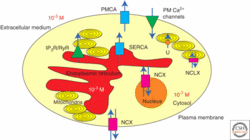Sandbox Reserved 654
From Proteopedia
(Difference between revisions)
| Line 8: | Line 8: | ||
---- | ---- | ||
== '''Introduction''' == | == '''Introduction''' == | ||
| - | <Structure load='1JM4' size='500' frame='true' align='right' caption='Insert caption here' scene=' | + | <Structure load='1JM4' size='500' frame='true' align='right' caption='Insert caption here' scene='<scene name='Sandbox_Reserved_654/Pcaf/1'>TextToBeDisplayed</scene>' /> |
The bromodomain is an evolutionary conserved motif found in chromatin remodeling complexes. It has been identified in over 100 proteins from multiple organisms ranging from unicellular microscopic eukaryotes (e.g., yeast) to humans. The motif is best known for the groundbreaking recent discoveries made to identify it as the only acetyl-lysine binding domain, Dhalluin, C. et al (1999) Nature 399, 491, and to reveal its highly specific ligand selectivity properties. Zeng, L. (2002) FEBS 513:1, 124. Due to these novel characteristics, bromodomains are typically found in proteins responsible for modifications in chromatin structure and the regulation of gene expression, such as histone acetyltransferases (HATs), and the ATPase subunits of chromatin remodeling complexes. There are several families of proteins with bromodomains. One such family is the human transcriptional coactivator p300/CBP-associated factor (PCAF) bromodomain, <ref> sample ref </ref> | The bromodomain is an evolutionary conserved motif found in chromatin remodeling complexes. It has been identified in over 100 proteins from multiple organisms ranging from unicellular microscopic eukaryotes (e.g., yeast) to humans. The motif is best known for the groundbreaking recent discoveries made to identify it as the only acetyl-lysine binding domain, Dhalluin, C. et al (1999) Nature 399, 491, and to reveal its highly specific ligand selectivity properties. Zeng, L. (2002) FEBS 513:1, 124. Due to these novel characteristics, bromodomains are typically found in proteins responsible for modifications in chromatin structure and the regulation of gene expression, such as histone acetyltransferases (HATs), and the ATPase subunits of chromatin remodeling complexes. There are several families of proteins with bromodomains. One such family is the human transcriptional coactivator p300/CBP-associated factor (PCAF) bromodomain, <ref> sample ref </ref> | ||
Revision as of 01:38, 18 November 2012
| This Sandbox is Reserved from 30/08/2012, through 01/02/2013 for use in the course "Proteins and Molecular Mechanisms" taught by Robert B. Rose at the North Carolina State University, Raleigh, NC USA. This reservation includes Sandbox Reserved 636 through Sandbox Reserved 685. | ||||||||||||
To get started:
More help: Help:Editing For more help, look at this link: http://proteopedia.org/w/Help:Getting_Started_in_Proteopedia
BROMODOMAIN (PCAF)Introduction
|
||||||||||||

